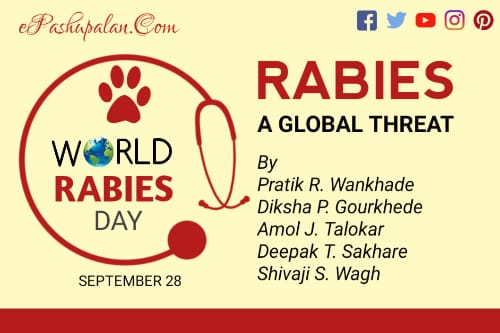The World Health Organization (WHO) celebrates “World Rabies Day” on 28th September every year to raise awareness about rabies prevention and to highlight progress in defeating this horrifying disease. Rabies is one of the oldest recognized disease affecting human and animals. At present one of the most important zoonotic diseases in India. It has been recognized in India since the vedic era.

Etiology of rabies
It means the cause agent of the disease condition. It is a highly fatal zoonotic viral disease affecting the central nervous system. Rabies is caused by lyssaviruses in the Rhabdovirus family. It is truly neurotropic and cause lesions only in nervous system.
Host range
The rabies, primarily is a disease of all warm-blooded animals, including dogs, cats, wolves, foxes, lions, monkeys, cows, horse, bats and humans. Bats act as a reservoir host for rabies viruses. The numbers of cases involving monkeys’ bites has been increasing in the last five years in India. It was reported that dogs were responsible for 91% of all human rabies cases. However, cat along with other domestic animals contributed 3% cases, bats2%, foxesl% and all other wild animals fewer than 1% cases.
Epidemiology of rabies
This disease occurs in most countries of the world. Though certain developed countries like New Zealand, Australia, Fiji, Germany, the United Kingdom, Ireland, Norway, Sweden, Finland, Iceland, Japan and Taiwan are free from incidence of rabies. Rabies kills around 55000 people annually, mostly in Asian and African countries. Some countries have implemented vigilant control measures and succeeded in eradicating the disease to meet the OIE requirements for rabies free status. However, in some countries the disease remains endemic. India has been reported as having the highest rate of human rabies in the world, because of stray dogs. Rabies is endemic in India. In India, about 15 million people were bitten by dogs, every year. Since 1985, India has reported an estimated 25,000 to 30,000 human death from rabies annually. A person is bitten every 2 seconds and someone dies from rabies every half an hour. The majority of people who die of rabies are people of poor or low socioeconomic status.
Route of transmission
The main route of transmission is by bites of rabid animals especially dogs. Transmission may also occur via aerosol route. The virus appears in the saliva, corneal fluids, milk of the affected animal and human. The virus cannot be demonstrated in the blood at any time. Not all the bites from rabid animals results in infection, because the virus is not always present in the saliva. The virus may be present in the saliva 5 days prior to symptoms exhibits. The virus may appear in the milk of affected animals but spread by this means is unlikely, because infection through ingestion is not known to occur.

Pathogenesis
Virus introduced into the body by the bite of rabid animal. Initially the introduced virus multiplies in the muscle. Then the virus enters the peripheral nervous system. It travels along the nerves and reaches spinal cord and then into central nervous system. Once the viruses reach the brain, it multiplies rapidly and cause encephalitis, at this time treatment is useless. Then virus reaches the salivary gland through sensory nerves from the central nervous system.
Symptoms
The rabies is 99% fatal after its symptoms and 100% preventable if treatment is administered at the right time. The incubation period is from 2 to 12 weeks; sometimes it may be as long as 2 years. If bites on the face or neck and shoulder regions, usually shorter incubation period than the bites on the extremities. The early symptom includes head ache and fever. Then the patient shows violent movement, fear, uncontrolled excitement and depression. The production of large quantities of saliva and tears coupled with an inability to speak or swallows are typical during the later stages of disease. The throat muscle is paralyzed and patient show fear of water. Due to this reason the name ‘hydrophobia’ is given to rabies.
Diagnosis of rabies
- Laboratory tests of secretions and biological fluids such as saliva, spinal fluid, tears, and tissues.
- Laboratory inspection of central nervous system (CNS) tissue removed from the cranium.
- FAT test, the most widely used test for rabies diagnosis recommended by both WHO and OIE.
- Inoculation of brain tissue, saliva or CSF in cell culture, or intracerebral inoculation in mice or in suckling mice.
- Detection of viral nucleic acids by PCR on tissue collected post mortem or intra vitam in a clinical specimen (brain tissue or skin, cornea, urine or saliva).
- Rabies virus isolated through intracerebral inoculation of suckling mice or by addition of suspensions of brain or saliva specimens to cultured mouse neuroblastoma cells.
Economic impacts of rabies
In developed countries, where canine rabies has been eliminated, the virus may continue to circulate in wildlife, whereas in most developing countries the principal reservoir is domestic dogs. An estimated 31,000 human deaths due to rabies occur annually in Asia, (WHO) with the majority – approximately 20,000 – concentrated in India. Deficient surveillance and the lack of reliable data on the number of rabies cases is a major constraint to assessing the economic impact of rabies on the local economies when livestock and domestic animals die due to rabies or infect humans. It causes many economic loses in many developing countries. Rabies transmitted by dogs is responsible for the loss of over 1.8 million DALYs (disability adjusted life years) every year, with direct and indirect economic costs (PEP, animal tests, dog vaccination, and livestock losses) totaling $5.5 billion per year. In addition to that its effects also included the costs associated with the risk of human mortality, resulted in a global cost for canine rabies of $120 billion. These virus disease result in about 24,000 to 60,000 deaths worldwide per year. More than 95% of human deaths caused by rabies occur in Africa and Asia. To mitigate this economic loss due to rabies, it is important to prevent through use of vaccine and environmental management.
Treatment &Control measures
- Immediately after exposure, thorough washing of wounds with soap and plenty of water for 5 min removes maximum virus particles. Antiseptics such as tincture iodine or povidone iodine or alcohol should be applied after washing.
- Treatment after exposure known as post exposure vaccination. It is highly successful in preventing the disease if administered promptly. An unimmunized person will be given a series of five total injections on Day 0, 3,7,14 and 28 of the exposure.
- The main aim of the vaccination is prevention of the virus entry in to the brain. If bites on faces or neck and shoulder region, the virus reaches the brain before the vaccine produces immunity. So Human Rabies Immunoglobulin, a readymade antibody will be given on Day 0. It will arrest the further movement of viruses.
- The 2004 survey revealed that about 60% of infected peoples restore to indigenous treatment. The use of Human Rabies Immunoglobulin in India is only 2%.
Management of stray animals especially dogs
The bond between humans and dogs had its beginning 12-14 millennia ago as assistant in the hunt of wild animals. Today, man violates that bond by allowing dogs to breed excessively and abandoning them in great numbers. It creates hazards for the dogs themselves as well as a considerable health risk to human society. India has approximately 25 million dogs, with an estimated dog: man, ratio of 1:36. More than80% of the dogs in India are stray dogs. Animal birth control program is carried out to control stray dog population in India. In this program, stray dogs are surgically sterilized, released back into the area from where they were picked up.
Conclusion and Recommendations
To overcome the public health threat and to handle economic loss of rabies, extension programs and consultancy services should be widely utilized to create awareness on the distribution and health hazards of rabies to the society. Collaborative work among governmental and non-governmental bodies including Public health sectors, veterinary sectors and other stakeholders is needed. Mass vaccination and registration of owned pets should be conducted at regular intervals. Appropriate legislative measures to reduce the numbers of stray dogs in such a way that do not cause avoidable pain or suffering. All groups at risk of acquiring the disease should take a pre-exposure vaccination. Rabies vaccination campaigns should be available and the cost of vaccines should be affordable for the society.
References
These will be provided on request to the authors.
|
The content of the articles are accurate and true to the best of the author’s knowledge. It is not meant to substitute for diagnosis, prognosis, treatment, prescription, or formal and individualized advice from a veterinary medical professional. Animals exhibiting signs and symptoms of distress should be seen by a veterinarian immediately. |








Be the first to comment